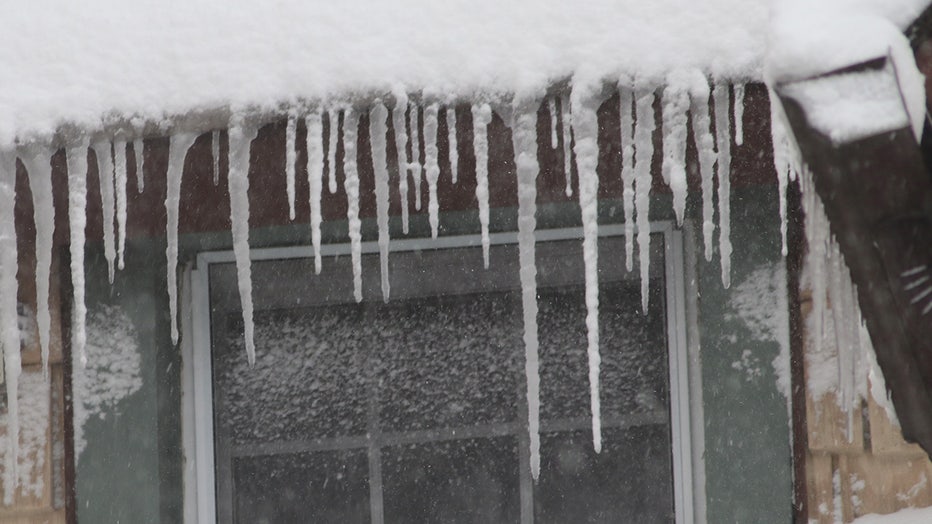CDC: How to prepare home, car for your next winter freeze
ATLANTA - As the winter season approaches in the United States, staying warm and safe can be challenging — especially during extremely cold weather and storms.
In fact, winter weather can bring bitter temperatures, power failures, loss of communication services and icy roads.

Icicles are seen on a roof of a house after heavy snowfall in Cliffside Park region of New Jersey, United States on February 01, 2021. (Photo by Islam Dogru/Anadolu Agency via Getty Images)
To keep yourself and your loved ones safe, the Centers for Disease Control and Prevention has issued guidance on how to prepare your home and your car before a winter storm hits.
Make a plan ahead of winter storm
The CDC suggests the key to being prepared for a winter storm is by planning ahead before winter weather hits.
According to the CDC, it’s important to check weather forecasts regularly and check your emergency supplies, including your emergency food and water supply, whenever you are expecting a winter storm or extreme cold.
RELATED: Biden's new winter COVID-19 plan includes reimbursement for at-home tests
Additionally, if you are in an area prone to winter weather, the CDC recommends creating a communication and disaster plan for your family ahead of time.
- Find phone numbers to your physicians, pediatrician, pharmacist, counselor and veterinarian.
- Collect important paperwork such as advance directives (living wills, power of attorney forms), an asthma action plan, a food allergy care plan and an emergency care plan for children with special healthcare needs.
- Ask a friend or relative who lives outside of your immediate area—preferably in another state—to be your family’s out-of-town contact.
- Identify a shelter-in-place location inside your home, a "sick room" that can be used to separate sick household members from those who are healthy, two emergency meeting places outside your home where your family can reunite in an emergency and at least two ways out of every room in your home.
The CDC recommends reviewing your plan every six months and updating it as necessary.
Prepare your home for winter storm
The CDC and National Weather Service recommend preparing your home, and this includes checking in on your four p’s: pets, pipes, plants and people.
- If you have pets, you should bring them indoors with it’s cold outside. If you cannot bring them inside, make sure to provide adequate shelter to keep them warm and make sure they have access to unfrozen water.
- Weatherproof your home by insulating any water lines that run along exterior walls so your water supply will be less likely to freeze. In addition, caulk and weather-strip doors and windows, insulate your walls and attic and install storm or thermal-pane windows or cover windows with plastic from the inside. Outside, repair roof leaks and cut away tree branches that could fall on your home or another structure during a storm.
- If you plan to use a fireplace or wood stove for emergency heating, the CDC suggests having your chimney or flue inspected each year.
- If you’ll be using a fireplace, wood stove, or kerosene heater, install a smoke detector and a battery-operated carbon monoxide detector near the area to be heated. Test them monthly and replace batteries twice a year.
- Keep a multipurpose, dry-chemical fire extinguisher nearby.
- Each winter season have your furnace system and vent checked by a qualified technician to ensure they are functioning properly.
- If you or a loved one are over 65 years old, the CDC says to place an easy-to-read thermometer in an indoor location where you will see it frequently. Our ability to feel a change in temperature decreases with age, and older adults are more susceptible to heath problems caused by cold temperatures.
Create an emergency car kit for winter weather
It’s important to get your car ready for winter weather, which includes having maintenance service on your vehicle as often as the manufacturer recommends.
Prior to the winter season, the CDC recommends have the radiator system serviced, or check the antifreeze level yourself with an antifreeze tester. Also, replace windshield-wiper fluid with a wintertime mixture, and check your heater, defroster, brakes, brake fluid, ignition, emergency flashers, exhaust, oil and battery to make sure your car is in good working order.
RELATED: Tornado killed 7 children on a single street in Kentucky
The CDC also suggests making sure the tires on your car have adequate tread and air pressure. The proper pressure recommended for your car is typically between 30-35 psi. Meanwhile, keep the gas tank near full to help avoid ice in the tank and fuel lines.
The CDC says it is best to avoid traveling during a winter storm, but if it’s necessary, the following items are recommended:
- Cell phone, portable charger, and extra batteries
- Items to stay warm such as extra hats, coats, mittens, and blankets
- Windshield scraper, shovel
- Battery-powered radio with extra batteries
- Flashlight with extra batteries
- Water and snack food
- First aid kit with any necessary medications and a pocket knife
- Tow chains or rope, tire chains
- Canned compressed air with sealant for emergency tire repair
- Cat litter or sand to help tires get traction, or road salt to melt ice
- Booster cables with fully charged battery or jumper cables
- Bright colored flag or help signs, emergency distress flag, and/or emergency flares
- Road maps

